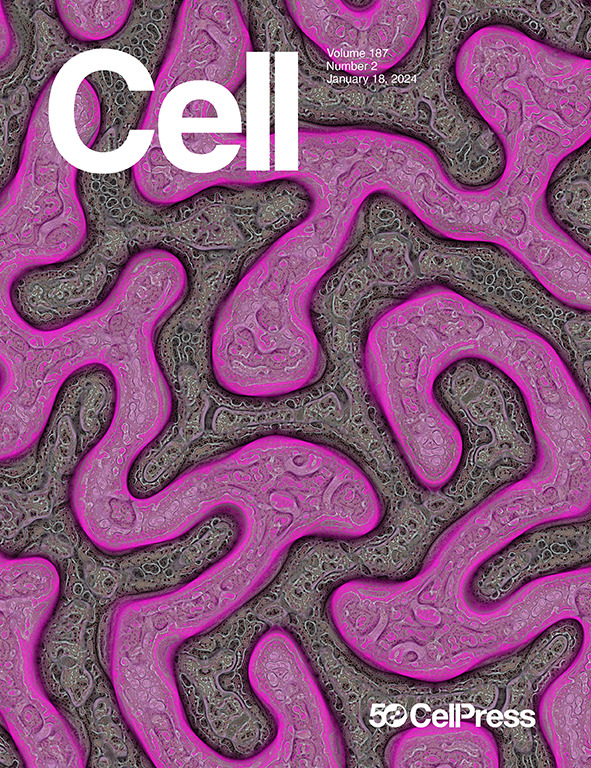原肠胚后羊膜作为干细胞衍生的人类胚胎外发育模型
IF 45.5
1区 生物学
Q1 BIOCHEMISTRY & MOLECULAR BIOLOGY
引用次数: 0
摘要
羊膜是哺乳动物胚胎中的胚胎外组织,被认为在怀孕期间提供重要的信号、结构和营养支持。尽管其至关重要,但由于缺乏准确的体外模型,对人类羊膜形成和功能的研究一直受到阻碍。在这里,我们提出了一个胚胎干细胞衍生的原肠胚后羊膜的3D模型,即原肠胚后羊膜(PGAs),该模型忠实地再现了受精后4周的胚胎外发育,密切模仿了人类羊膜囊的功能特征。PGAs自组织,形成羊膜和卵黄囊,并被胚外中胚层包围。利用PGAs,我们发现GATA3是羊膜形成所必需的和充分的,并且一个自调节反馈回路控制羊膜的形成,由此胚胎外信号促进羊膜规范。PGA系统的可重复性和可扩展性,以及其精确的细胞、结构和功能完整性,为研究原肠胚形成之外的胚胎-羊膜相互作用开辟了途径,并为大规模药理和临床研究提供了理想的平台。本文章由计算机程序翻译,如有差异,请以英文原文为准。

Post-gastrulation amnioids as a stem cell-derived model of human extra-embryonic development
The amnion, an extra-embryonic tissue in mammalian embryos, is thought to provide crucial signaling, structural, and nutritional support during pregnancy. Despite its pivotal importance, studying human amnion formation and function has been hampered by the lack of accurate in vitro models. Here, we present an embryonic stem cell-derived 3D model of the post-gastrulation amnion, post-gastrulation amnioids (PGAs), that faithfully recapitulates extra-embryonic development up to 4 weeks post-fertilization, closely mimicking the functional traits of the human amniotic sac. PGAs self-organize, forming the amnion and the yolk sac, and are surrounded by the extra-embryonic mesoderm. Using PGAs, we show that GATA3 is required and sufficient for amniogenesis and that an autoregulatory feedback loop governs amnion formation, whereby extra-embryonic signals promote amnion specification. The reproducibility and scalability of the PGA system, with its precise cellular, structural, and functional integrity, opens avenues for investigating embryo-amnion interactions beyond gastrulation and offers an ideal platform for large-scale pharmacological and clinical studies.
求助全文
通过发布文献求助,成功后即可免费获取论文全文。
去求助
来源期刊

Cell
生物-生化与分子生物学
CiteScore
110.00
自引率
0.80%
发文量
396
审稿时长
2 months
期刊介绍:
Cells is an international, peer-reviewed, open access journal that focuses on cell biology, molecular biology, and biophysics. It is affiliated with several societies, including the Spanish Society for Biochemistry and Molecular Biology (SEBBM), Nordic Autophagy Society (NAS), Spanish Society of Hematology and Hemotherapy (SEHH), and Society for Regenerative Medicine (Russian Federation) (RPO).
The journal publishes research findings of significant importance in various areas of experimental biology, such as cell biology, molecular biology, neuroscience, immunology, virology, microbiology, cancer, human genetics, systems biology, signaling, and disease mechanisms and therapeutics. The primary criterion for considering papers is whether the results contribute to significant conceptual advances or raise thought-provoking questions and hypotheses related to interesting and important biological inquiries.
In addition to primary research articles presented in four formats, Cells also features review and opinion articles in its "leading edge" section, discussing recent research advancements and topics of interest to its wide readership.
 求助内容:
求助内容: 应助结果提醒方式:
应助结果提醒方式:


